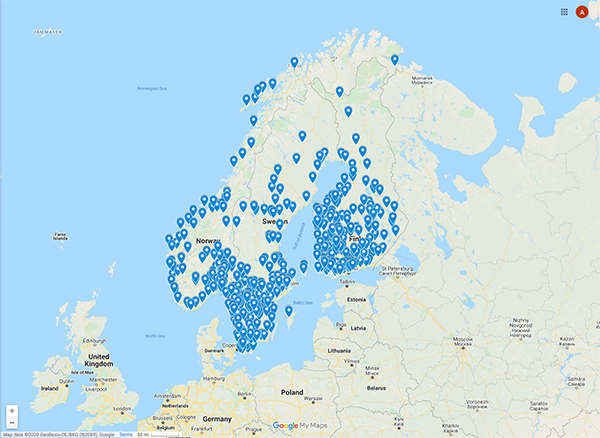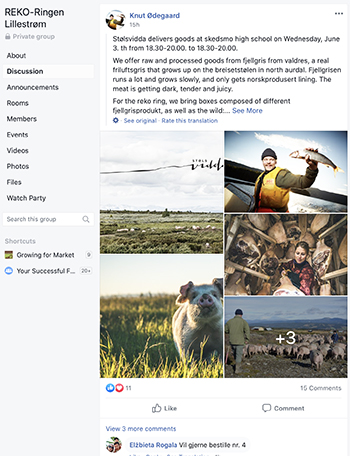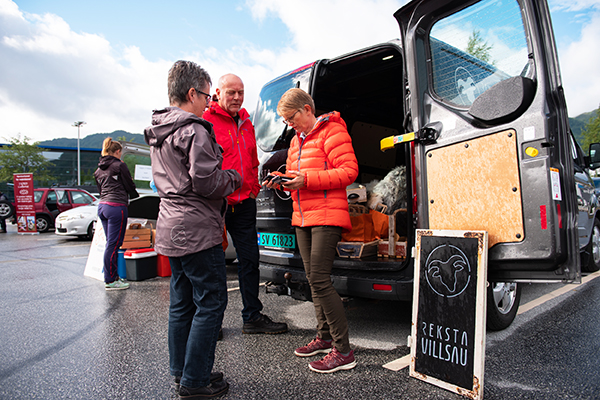By Andrew Mefferd
In the scramble for local producers to put their wares and transactions online, REKO rings allow growers to advertise and sell digitally, and drop off presold goods at a predetermined time and place. Never heard of a REKO ring? Neither had I until Rebekka Bond contacted me from Norway back in December.
She told me the model was catching on in Scandinavia, and it might be something the rest of our readers would be interested in too. And though they started before COVID, REKO rings may be a good way for local growers to move sales online and deliver goods with a minimum of congregating. But first, what the heck is a REKO ring?
What is a REKO ring?
REKO is a Swedish acronym variously translated as “real consumption,” “fair consumption” or “sincere consumption” (you get the idea). It was invented by Finnish farmer Thomas Snellman, who was looking for a better outlet than grocery stores for his wares. If you want to watch a TED Talk with Snellman talking about how he invented it, you can see it at youtube.com/watch?v=ETHa7MPEl1A.
And by “ring,” we mean a group of people cooperating for a shared purpose. The usage that comes to mind is an illicit drug distribution ring, but substitute local food and flowers for drugs and you’ve got the idea. This is a ring for distributing something wholesome instead of something illegal.
It’s really simple so before going any further let’s talk about how a REKO ring works. First you start a closed Facebook group (closed meaning only people who are approved by the administrator can join, so you can control who has access to your REKO ring). Rings correspond to producers in a given geographic area, so if I wanted to start a ring I might call it REKO ring Cornville (since I live in Cornville, Maine) and I might invite producers within 45 minutes of Cornville to join.
Basically, a REKO ring takes the classic model of a farmers market and moves the advertising and buying to Facebook. The money changes hands (often digitally) through the grower’s preferred payment method. Then all the growers in a given ring show up at the same predetermined time and place, so that if customers have purchased from multiple growers in the ring, they can quickly get all their purchases from anyone in the ring at the same time.
The big difference between this and a traditional farmers market is that farmers only show up with presold goods; there’s no standing around hoping to sell what you’ve brought. And, because everything is presold, the pickup times are much shorter than a traditional farmers market, usually somewhere between half an hour and two hours.
At the beginning of a given week, producers make a post offering what they have available to the group and the price. For example, a basic offer might be “organic red beefsteak tomatoes $4/#.” Though a nice photo of the goods or your farm is likely to sell more than just text.
Customers order by commenting on the original post from the grower. For example, a customer who wanted to respond to the above offer would put a comment under the post, something like “I’ll take 4 pounds of the organic red beefsteaks.” Then it’s up to the customer to pay the grower and pick the goods up at the predetermined time and place.
In the past, it seems most producers accepted payment when the goods were picked up. But in the COVID era, most REKO rings have transitioned to online payment through PayPal, Venmo, Square, or other online payment methods. In addition to reducing physical contact and speeding pickup, some big advantages I can see for producers are that 1) it’s great to get paid in advance and 2) people are much more likely to pick their stuff up if they’ve already paid for it.

This map has markers showing the 500+ REKO rings in Norway, Sweden and Finland.
Flexibility
One beauty of REKO is that you can set it up however you want to. I can tell you some best practices that I learned from talking with practitioners, but there are very few hard and fast rules with a REKO ring.
First and foremost, you still have to follow local laws regarding food safety and tax. After that, the sky’s the limit as far as customizing your REKO ring for your particular market. For example, most of the REKO rings I’ve seen have multiple administrators and multiple producers to give the ring a wider variety of products. But it could also work with a single producer starting their own ring, either because they have a variety of products or are in an area isolated from other producers.
After that, you can use any payment method, pickup time, pickup location etc. that you want. The whole idea behind using a closed Facebook group is that you can exclude anyone who isn’t a serious buyer, or who violates group rules like conversational commenting or trying to run their own ads in the feed.
Posting by producers is for advertising their wares and posting by buyers is for ordering only. No one wants the offers made by producers to be obscured by a bunch of chatting. Some groups put a limit on how far away producers or buyers can live from the locality, to keep it local and encourage the development of other rings for other areas.
Starting a REKO ring
After setting up a closed Facebook group, the next thing to do would be to choose a delivery time and location. Some rings use someone’s farm, or the parking lot of a local business. Most rings use a fairly short pickup timeframe, since one of the advantages of this business model is that it doesn’t eat up as much time as a farmers market. And of course, everything is presold, so no more standing around watching your greens wilt for six hours because the weather is bad and people don’t want to come to market.
Producers show up at the allotted time and distribute the pre-sold goods to the customers as they show up. These are the basics and outside of this there are not many hard rules for REKO.
One best practice I heard frequently is that most administrators clear out the feed after each pickup day. For example, if the pickup day were Saturday, administrators would clear the feed the following day on Sunday and invite producers to make a new offer for the following Saturday. Clearing out the feed each week keeps it from becoming cluttered with the previous week’s offers and orders.
Most rings shut down ordering a day or two before pickup to give time for online transactions to take place and for the farmers to pack up their orders. For example, a weekly schedule for a pickup that takes place on a Saturday might look like: administrators clear out the previous week’s posts the Sunday following a Saturday pickup, and allow new offers from Sunday through Thursday, cutting off orders Thursday at midnight to allow Friday and Saturday morning for online transactions and packing up orders. The producers show up with their wares on Saturday, and the whole cycle starts over again on Sunday.

This is a screen shot from Facebook of a producer’s ad from a REKO ring in Norway. The producer has advertised their wares
and prices in this post and customers are ordering by commentng their orders below the post.
REKO in Norway
Rebekka Bond, who first tipped me off about REKO back in December, had worked for a small farmers union in Norway helping to promote REKO rings. She said, “I have been working with REKO since 2017 when we went to Sweden to study the model. I worked on a project to motivate farmers to start local food companies.”
“For some people it’s easier to produce than to sell their goods. Then I found REKO and it was just extremely good, especially for startups and new producers with no customers yet. After I found REKO, I thought, ‘I will use this project to establish REKO in Norway.’ So now we have maybe 100 different REKO groups all over the country,” said Bond.
More recently, she moved back to the farm she grew up on outside the capital of Oslo. Now she is the administrator for a ring that she is also a producer for, called REKO Lillestrom. Her REKO now has 20,000 members, but she said that out of all those people, around 500 of them order in any given week.
“That’s a lot of people, and COVID has changed it. Farmers that usually deliver to restaurants, now they don’t have any buyers, so they use REKO. Now we have at least double the number of producers. We have 60 producers coming every Wednesday. So, it’s crowded. But it’s fun. And consumers are really happy because now they can find anything from seafood to meat and eggs,” said Bond.
She told me the first REKO ring was formed in Finland in 2013, and now there are over 500 rings in Skandinavia, with and estimated 5% of the population of Finland participating in one. Now that REKO has taken root in Scandinavia, it is starting to move out into the rest of the world, and COVID may well hasten that process.
Regarding the work of becoming an administrator and getting people used to the model, Bond says, “Every delivery, you have to explain the basics. It’s pretty simple, but there are always new members joining the group and new farmers too. So, the main administration job is to explain what REKO is and how it’s done and how you order and how you pick up.”
“Have there been adjustments to the way people pick up because of COVID?” I asked.
“The administrator of each group did it a bit differently. I administer two groups and we kept them open the whole time. Some of the groups chose to close for a few weeks because they were nervous. Nobody knew how to deal with COVID and they were afraid they were going to do something wrong or not be able to keep people apart,” said Bond.
“Previously, one delivery for us lasted 30 minutes. But after COVID we changed it so delivery lasts one and a half hours. And we increased spacing between the farmers in the parking lot. And then we made a new rule that all orders have to be prepaid.”
“In the past people usually paid when they picked up. Prepayment is probably something many farmers will continue with because it’s better. They know they’re going to get paid and it makes pickup easier and it goes quicker. You don’t have to stay at the parking lot for a long time. So, that’s what we did. And now all the farmers have hand sanitizer and gloves,” said Bond.
She says if you’re interested in starting a REKO ring, one of the best ways to get up to speed is by joining one of the closed Facebook groups to see how they work. You might need to send the administrators a message to let them know why you want to join if you’re from outside their area! But then once you join a group, you can follow it for a few weeks to see how it works and then use that as a template to start your own group.

Above is a photo from a REKO ring delivery in Norway before the COVID pandemic. Now vendors are doing
prepayment only and social distancing. Photo courtesy of Rebekka Bond.
REKO as a response to COVID
After hearing about the success of REKO in Scandinavia, I wondered how it was going in North America. I could only find three REKO rings in the United States, and I was able to talk with all of them. Let us know if you know of others or if you start a REKO ring!
I talked with Tia Groves of Groves Country Mushrooms, who is the administrator for a ring in Idaho called REKO- Treasure Valley. As of late May, their closed Facebook group already has 3,600 members. She said, “Reko has been a fabulous outlet for us here in Boise, Idaho! My husband heard about Reko back in January and asked me to spearhead starting one here. I was overwhelmed at the time but when Covid hit, we lost many of our markets and farmers markets were postponed or canceled so we had to get creative.”
“We started REKO- Treasure Valley with just a few of our friends that were fellow vendors at the local farmers market and asked everybody to share our group on their social media platforms. We all did so often, and within weeks, our group had thousands of members and was incredibly successful. Since restaurants and farmers markets are now reopening, we have noticed a bit of a drop off in sales, but our vendors are still doing very well.”
“This outlet offers a midweek selling/shopping option for vendors and customers that we all seem to love and appreciate. Our community has always been awesome about supporting local and shopping small. Since COVID, we’ve seen an even greater influx of people wanting to know where their food is coming from and valuing the good ethics behind the farm.”
“It’s also incredibly convenient for the farmer! With everything based on Facebook and strictly preorders, we have no waste and can always be sure of exactly what needs to be reserved for REKO. There has definitely been a learning curve to managing the group, but it continues to be very well worth our time and effort. REKO has blessed so many of our lives and businesses here in Idaho and I am excited to watch it continue to grow!”
REKO in North America
I talked with Julie Kintzi, one of the admins for the Enumclaw, Washington, REKO-Market. Though they’ve only been operating the REKO for around a month, they are still one of the first in the USA.
“This was meant to be our test month [May] to see how it would go. Initially we thought we may do this to fill in the gaps before the farmers market starts. But our members seem to want to continue it at least for now. And so far, some vendors are doing very well. We have 765 members and I’d say maybe 100 of those are buying. So, I’m encouraging people to tell their friends and to buy because if they don’t buy then there’s no point in having the market,” said Kintzi.
Julie said that even though there aren’t a lot of hard and fast rules for setting up a REKO, it’s important to be aware of what state and local rules apply to you. Because depending on how it’s configured, municipalities may regulate a business differently if it’s called a farmers market, or a popup market, or a farmstand. For example, in her case regulations stipulate that in order to do a REKO-style pick up, there has to be a refrigerator for chilled goods, not just a cooler. So they made their pickup at a farm that has active refrigeration.
I talked with Traci Mitchell, who is the administrator of the REKO Ring Denver, and also a vendor with her business Mile High Microgreens. “I found out about REKO from Diego Footer’s podcast, Farm Small Farm Smart,” said Mitchell. You can find a link to that podcast at https://tinyurl.com/y75kc22g.
“He basically just got my brain ticking and I thought, ‘I need to see if there’s one in Colorado already.’ And I typed in Denver REKO ring, Colorado REKO ring and nothing came up. So I thought, ‘You know what? During these crazy times right now with the coronavirus, I’m just going to go for it. There’s no reason to sit on this,’” said Mitchell.
“My husband and I own Mile High Microgreens. We were distributing to restaurants, but all the restaurants pulled their orders. So we had to go through a scramble of landing more customers, which has happened, but it’s been a slow build. And then we spend lots of time in our cars dropping off. So I thought, ‘How can we make our time more efficient? Because we don’t like to be delivery drivers. Once a week is fine, but having it be multiple times a week seems insane,’” said Mitchell.
As far as how it’s going, the Denver REKO had only been around for about a month when we talked so it’s too early to say. At this point Mitchell is still working to get more producers and buyers to join. But based on the success of the model in Scandinavia, the potential is great. We’ll check back in with everyone this winter to see how the season went.
Are you running a REKO ring or plan on starting one? If so, please let us know how it goes, and if you learn any tips or tricks we didn’t already mention here.
Andrew Mefferd is the Editor of Growing for Market. He farms in Maine.
